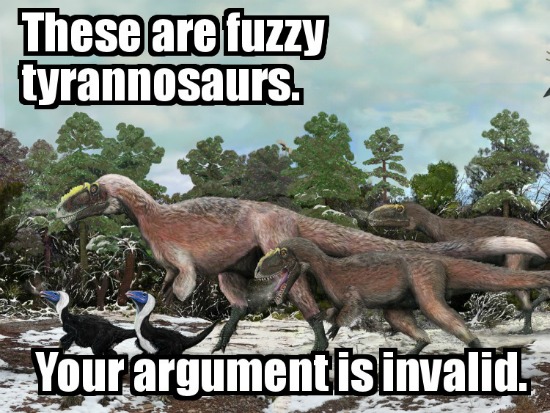Why Is It Cool To Hate On Dinosaur Discoveries?
Tyrannosaur traditionalists are registering their displeasure at the way paleontologists are altering our understanding of dinosaur lives
/https://tf-cmsv2-smithsonianmag-media.s3.amazonaws.com/filer/20120427125015yutyrannus-thumb.jpg)
When I first heard the news that paleontologists had discovered a giant, fuzzy tyrannosaur, I was giddy with excitement. The dinosaur, dubbed Yutyrannus, was a confirmation of an idea that researchers and artists had been cautiously exploring for years. While most of the feathered dinosaurs discovered so far have been very small and often quite bird-like animals, Yutyrannus was a roughly 30-foot-long bruiser which showed that even huge predators might have sported fluffy plumage. And if an imposing predator like Yutyrannus sported a fuzzy coat, the same might be true for the theropod’s notorious cousin, Tyrannosaurus rex. The tyrant king may not have been the wholly scaly monstrosity I grew up knowing, but an apex predator decorated by patches of simple protofeathers.
Not everyone shared my enthusiasm. “Tyrannosaurs were supposed to be scaly,” came the cantankerous cry from die-hard fans of more reptilian dinosaurs. Why are paleontologists so committed to destroying the fantastic imagery Jurassic Park embedded in our cultural landscape? Across the web, tyrannosaur traditionalists registered their displeasure. “Oh, how the mighty have fallen!” mourned one WIRED commenter, and elsewhere, Yutyrannus was presented as a “fuzzball” and “chicken from hell.” And while the outrage was not as great as when people mistakenly believed that paleontologists were trying to kill Triceratops, at least some dinosaur fans lamented the increasingly avian aspect of tyrannosaurs.
![]()

A restoration of Yutyrannus, with the therizinosaurs Beipiaosaurus in the foreground, by Brian Choo. Caption added by the author.
Paleo blogger Mark Wildman recently jumped in with a post titled “In Defence of Scaly Dinosaurs.” He was sad to see yet another proud dinosaurian lineage turn fluffy. “Those of us who like our dinosaurs scaly appear to be frowned upon,” Wildman wrote, “as if we don’t know what we are talking about and that we really ought to ‘get with it’ and rejoice that the dinosaurs are covered in fuzz and feathers. Well that isn’t going to happen—certainly not by me and, I am sure, not for many others.” And to dapple Tyrannosaurus with feathers would be the ultimate indignity. Citing the awesomeness of Tyrannosaurus in Dinosaur Revolution, and how silly the feathery Gigantoraptor looked, Wildman challenged readers: “Do you really want the ultimate theropods, the megastars of the dinosaurian world—the tyrannosaurs—displaying colourful yet gaudy feathers and dancing like a demented turkey cock?”
I actually wouldn’t mind a strutting tyrannosaur, even though I admit that Dinosaur Revolution‘s Gigantoraptor sequence was a little over the top. And none of this is to say that Wildman objects to the evidence of feathered dinosaurs. He makes it quite clear that he’s entirely on board with the science. All the same, his post and other comments about how Yutyrannus has somehow ruined tyrannosaurs made me wonder about why it is so fashionable to register cranky displeasure with the way dinosaurs have changed. Some people just don’t like feathery dinosaurs, many wept and wailed at the false assertion of journalists that Triceratops might disappear, and “Brontosaurus” still stirs up strong feelings among those who grew up with the thunder lizard. It’s cool to show contempt for new discoveries in favor of the dinosaurs we grew up with. Before I knew the extent of the evidence, even I felt a little sad that so many of the scabrous, ugly dinosaurs I met as a kid were turned into pretty peacocks.
I can’t explain why this is so any more than I can explain why we adore dinosaurs in the first place. I don’t think anyone has successfully articulated why we’re so enthralled by these creatures. But I think Mike Brown identified one important thread in his book How I Killed Pluto and Why it Had it Coming. When Pluto was officially demoted from planet to dwarf planet, many people objected to the loss of one of our solar system’s icons. Brown recalled:
In the days that followed, I would hear from many people who were sad about Pluto. And I understood. Pluto was part of their mental landscape, the one they had constructed to organize their thinking about the solar system and their own place within it. Pluto seemed like the edge of existence. Ripping Pluto out of that landscape caused what felt like an inconceivably empty hole.
Of course, Pluto didn’t actually go anywhere. Its title simply changed. But the alteration virtually obliterated the cosmic body in people’s minds. Might the same be true for dinosaurs? For those of us who grew up with scaly, swamp-dwelling dinosaurs, the new images of fuzzy dinosaurs are conflicting with the Mesozoic world as we think it should be. A Tyrannosaurus with feathers isn’t really a Tyrannosaurus, but a different sort of creature that doesn’t quite fit what we had in mind for so long. This tension is inevitable. There is so much that remains unknown that any vision of the past is certainly going to change. I have no doubt that, a few decades from now, children who grew up with feathery dinosaurs will lament how future generations of paleontologists are altering the picture of dinosaur lives.
/https://tf-cmsv2-smithsonianmag-media.s3.amazonaws.com/accounts/headshot/RileyBlack.png)
/https://tf-cmsv2-smithsonianmag-media.s3.amazonaws.com/accounts/headshot/RileyBlack.png)